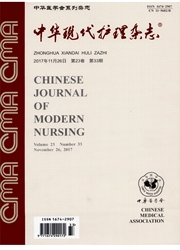

 中文摘要:
中文摘要:
目的:探讨脑卒中高危患者实施护理门诊综合干预的措施及效果评价。方法采用便利抽样法选择2014年4—12月于门诊就诊的75例脑卒中高危患者,实施脑卒中护理门诊综合干预措施,包括监测血压、体质量、腹围,指导合理运动、用药、饮食等,及干预效果评价。结果实施干预措施6个月,干预人群收缩压从(148.40±13.86)mmHg 下降至(133.1±12.49)mmHg,舒张压从(84.75±8.50)mmHg 下降至(79.75±7.40)mmHg,差异有统计学意义(P <0.05);合理运动依从率由41.3%提高至72.9%,吸烟率从53.3%降低至21.4%,服药依从率由52.0%提高至85.7%,饮食偏咸率从56.0%降低至37.1%,偏油率从69.3%降低至15.7%,进食水果依从率由38.7%提高至90.0%,饮食牛奶依从率由30.7%提高至75.7%,干预前后差异有统计学意义(P <0.05)。结论脑卒中高危患者实施门诊综合干预措施,可以减低脑卒中的危险因素,改善其生活方式。
 英文摘要:
英文摘要:
Objective To explore comprehensive nursing measures to the high-risk patients with cerebral apoplexy in nursing outpatient and evaluate the effect.Methods Convenience sampling method was used to select 75 high-risk cerebral apoplexy patients in the nursing outpatient from April 201 4 to December 201 4,patients were carried out comprehensive nursing measures including measuring blood pressure,body weight,and abdominal circumference,instructing to take medication correctly and establish a healthy physical exercise and diet style.Results After 6 months of intervention,systolic blood pressure and diastolic blood pressure of the subjects decreased from (1 48.40 ±1 3.86)mmHg to (1 33.1 ±1 2.49)mmHg and (84.75 ± 8.50)mmHg to (79.75 ±7.40)mmHg respectively(P 〈0.05).Before and after intervention,the reasonable exercise rate rose from 41 .3% to 72.9%,smoking rate decreased from 53.3% to 21 .4%,compliance with medication rose from 52.0% to 85.7%,salty diet rate decreased from 56.0% to 37.1 %,oiled diet rate decreased from 69.3% to 1 5.7%,compliance with fruit intake rose from 38.7% to 90.0%,compliance with milk drink rose from 30.7% to 75.7%(P 〈0.05).Conclusions Outpatient comprehensive stoke intervention measures to patients with high-risk for cerebral apoplexy can reduce the risk factors to stoke,improve lifestyle and provide basis for stoke high-risk population.
 同期刊论文项目
同期刊论文项目
 同项目期刊论文
同项目期刊论文
 期刊信息
期刊信息
